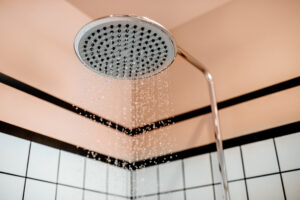Few things are more irritating than a leaky faucet. That constant drip not only disturbs your peace but also wastes water and increases your utility bills. According to the U.S. Environmental Protection Agency, leaks across American households waste nearly 1 trillion gallons of water every year. Many faucet leaks are caused by common, easily identifiable issues that you can often fix yourself with a few simple tools. In this guide, we explain the seven primary causes of a leaky faucet and offer clear, practical fixes. We also briefly cover how to troubleshoot the problem and when it’s best to call in professional help to save you time, money, and stress.
Most Common Causes of a Leaky Faucet
Faucet leaks usually result from a limited number of problems. Here are the seven most prevalent causes and what you can do to fix them.
1. Worn-Out Washers or O-Rings
Washers and O-rings form seals that prevent water from escaping. Over time, friction, water exposure, and age cause these parts to crack or lose flexibility. If you see moisture around the faucet handle or a small drip when the faucet is off, remove the handle (after shutting off the water supply) and inspect these parts. Replacing a damaged washer or O-ring is a quick, inexpensive fix that often resolves the leak.
2. Faulty Cartridge
Modern faucets often use a cartridge to control water flow and temperature. With continual use, mineral buildup or wear can damage the cartridge’s seals, leading to leaks or erratic handle movement. If your faucet drips even when closed or the handle feels loose, consider replacing the cartridge. Ensure you purchase the correct model for a proper fit, as compatibility is crucial.
3. Corroded Valve Seat
The valve seat connects the faucet spout to its base. Constant exposure to mineral-rich water can corrode this metal component, creating gaps that allow water to seep out. Check for signs of rust or mineral deposits near the spout. If cleaning and descaling do not resolve the leak, replacing the valve seat may be necessary.
4. Loose or Worn-Out Parts
Faucets consist of many small components like screws, nuts, and seals. Continuous use and vibrations can cause these parts to loosen or deteriorate. Leaks around the handle or base often indicate that a screw or gasket has become loose. Visually inspect your faucet and tighten any loose components carefully. Replace parts that show signs of wear to restore watertight connections.
5. High Water Pressure
Excessive water pressure stresses your plumbing system and can lead to intermittent drips. If your faucet only leaks during low-demand periods, test your home’s water pressure with a gauge. Pressures above the recommended range of 40–60 psi may indicate that installing a pressure regulator is needed to protect your faucet and other fixtures.
6. Worn-Out Gaskets or Seals
Gaskets and seals keep water contained between faucet components. Over time, constant water flow and mineral buildup can cause them to degrade. This often results in persistent leaks at the connections between handles or at the spout. If you notice these signs, it might be time to disassemble the faucet and replace the worn seals or gaskets.
7. Mineral Deposits or Build-Up
Hard water can cause minerals like calcium and magnesium to accumulate inside your faucet, clogging the aerator and damaging internal parts. Look for white or green scaling around the faucet tip. Regular cleaning by soaking affected components in white vinegar can dissolve the buildup. For persistent issues, adding a water softener to your home may help prevent future deposits.
How to Troubleshoot Your Leaky Faucet

A systematic inspection is key to pinpointing the source of the leak. Follow this concise checklist before deciding whether to tackle repairs yourself:
- Turn Off the Water Supply: Shut the valves under the sink to stop water flow.
- Dry and Inspect: Wipe down the faucet exterior to detect fresh leaks and inspect for moisture around joints and handles.
- Identify the Faucet Type: Recognize whether your faucet is a compression, cartridge, ball, or ceramic disk model. This influences the repair process.
- Examine Internal Components: Disassemble accessible parts—such as the handle and the spout—and check washers, cartridges, and seals for signs of wear, corrosion, or buildup.
- Test the Aerator: Unscrew the aerator and clean it if clogged, as mineral deposits can also cause uneven flow or minor drips.
If the problem remains unclear after these steps or if significant corrosion or hidden leaks are suspected, it is best to consult a professional plumber.
Step-by-Step: DIY Leaky Faucet Fixes
Many common faucet issues can be resolved with a few basic tools and minimal plumbing knowledge. Here’s a streamlined guide to fix typical problems:
Replacing a Washer or O-Ring
- Shut Off the Water: Turn off the water supply to avoid leaks.
- Disassemble the Handle: Remove screws (often hidden) to access the valve stem.
- Remove and Inspect: Take out the washer or O-ring and check for cracks or brittleness.
- Replace and Reassemble: Install the new part, reassemble the faucet, and gently tighten all components.
- Test the Result: Restore the water supply and verify that the leak has stopped.
Replacing a Faulty Cartridge
- Turn Off the Water: Prevent spillage by shutting off the water supply.
- Remove the Handle: Unscrew the faucet handle to expose the cartridge.
- Extract the Old Cartridge: Remove any retaining clips or nuts and take out the cartridge.
- Insert the New Cartridge: Match the new cartridge to your faucet model and secure it properly.
- Reassemble and Test: Reattach the handle and turn the water back on to confirm an effective repair.
Cleaning the Aerator
- Remove the Aerator: Unscrew the screen from the faucet tip.
- Soak in Vinegar: Submerge it in white vinegar to dissolve mineral deposits for at least 30 minutes.
- Scrub and Rinse: Gently brush away any remaining buildup, rinse thoroughly, and reinstall.
Tightening Loose Parts
- Inspect Connections: Check for any loose screws or fittings around the faucet.
- Tighten Gently: Use the appropriate tool to firm up any loose components without over-tightening.
- Test the Faucet: Turn on the water and observe if the leak has been corrected.
Preventative Maintenance Tips
- Clean aerators regularly by soaking them in vinegar.
- Monitor water pressure and maintain it within the recommended range.
- Periodically inspect washers, seals, and gaskets and replace them at the first sign of wear.
- Consider installing a water softener if hard water is a recurring issue.
When Should You Call a Professional Plumber?

While many leaks can be fixed at home, some scenarios require expert intervention. Call a professional plumber if:
- The faucet continues to leak after multiple DIY attempts.
- There is significant corrosion or severe internal damage.
- Leaks appear in inaccessible areas such as behind walls or under cabinets.
- Water quality issues, like discoloration or unusual odors, accompany the leak.
- You are not confident in disassembling or reassembling faucet parts.
Relying on professionals prevents further damage and ensures that repairs are done correctly the first time.
Frequently Asked Questions
How much water does a dripping faucet waste?
A faucet that drips once per second can waste over 3,000 gallons of water each year. This not only harms the environment but can also lead to a noticeable increase in your water bill. For more insights into how even small drips add up, the AWWA Drip Calculator can help you quantify potential water waste at home.
Is a leaking faucet dangerous?
A leaking faucet might not pose an immediate hazard, but persistent drips can lead to mold, mildew, and structural damage. Water leaks near electrical systems can also be risky.
Can a leaky faucet increase my water bill?
Yes, even minor leaks can cumulatively waste a significant amount of water, leading to higher utility bills over time.
How much does it cost to fix a leaky faucet?
Simple repairs, such as replacing washers or cartridges, are quite affordable. However, more complicated issues may require professional services, which can be more expensive. It’s usually more cost-effective to repair promptly than to deal with water waste and damage later.
Is it better to repair or replace a faucet?
If the faucet is relatively new and repairable with available parts, fixing it is usually the best option. For older faucets with recurring issues or extensive damage, replacement might be more economical in the long run.
Why Choose Hydromax Plumbing to Fix Your Leaky Faucet
Hydromax Plumbing is your trusted local partner in Evansville, Indiana. With decades of experience and a reputation for quality service, our licensed professionals are available 24/7 for both emergency repairs and routine maintenance. With over 47 years of experience, Hydromax Plumbing has built a strong track record in handling a wide range of plumbing issues, from clogged drains to pipe bursts, making us a reliable choice for your home or business plumbing needs.
Ready to Stop Your Drip?
Don’t let a leaky faucet disrupt your life or damage your home. Whether you’re comfortable attempting a DIY repair or need expert help, taking swift action is essential. Contact Hydromax Plumbing for prompt, professional service. Let us help you enjoy reliable, worry-free plumbing by stopping the drip once and for all.




